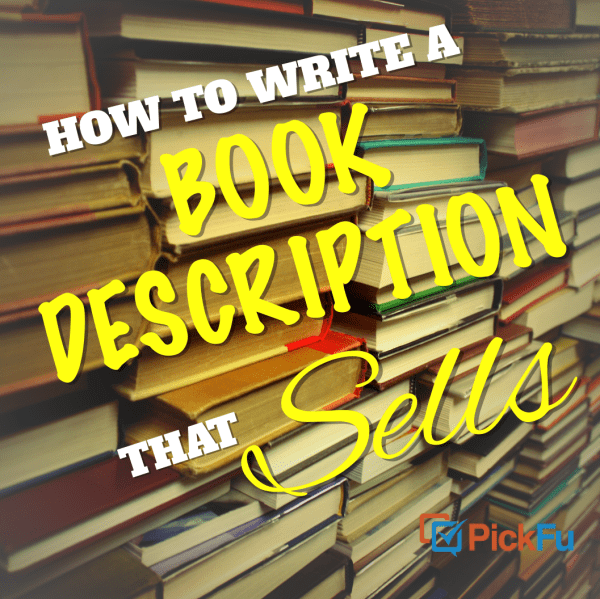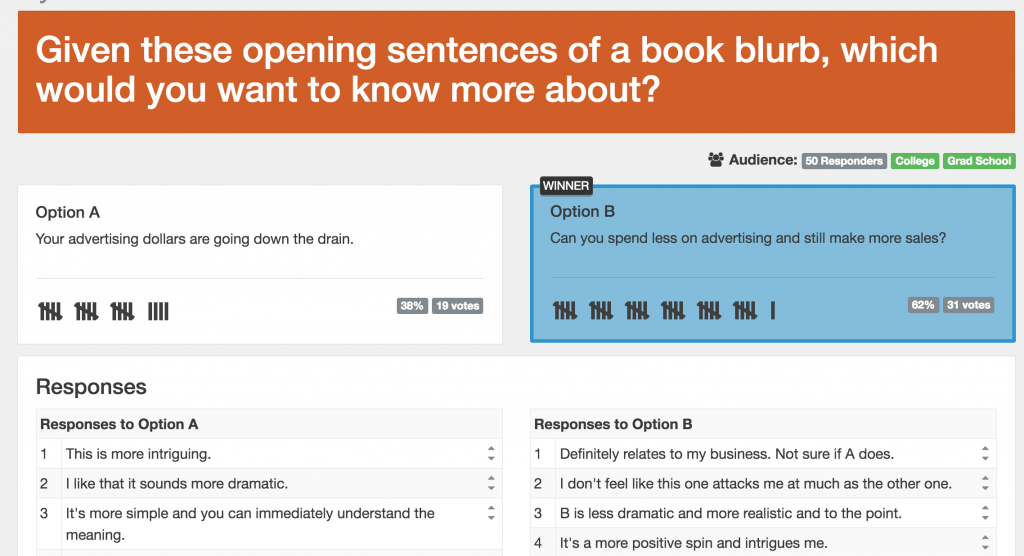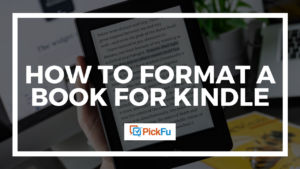Some might say that writing is its own reward. But once you’ve put your book up for sale, sales can be an even better reward.
Many users turn to PickFu to test book titles and cover designs. But PickFu can help you hone a book’s description, too. Below are tips from self-published authors on what makes a book description sing — and how to get the cash register to ring.
Focus on value to the reader
You’ve reeled a potential reader in with a strong title and attractive book design. They’ve clicked on your description page. Now what?
Mihaela Lica Butler, author of the cookbook Vegan Romania and the children’s book Garden Super Hero Tales advises that authors tell the reader what’s in it for them.
“Generally speaking, value should be a strong focus,” she says, “and value comes in different forms.” Various means of conveying value may include the author’s expertise on the subject, the book’s affordability, content exclusivity (not being able to find the information within the book anywhere else), or features like recipes, interactive content, or illustrations and coloring pages.
In her description of Vegan Romania, Butler explains why a vegan diet isn’t traditionally associated with Romania, but how it plays an important part in daily life there.
Romania is little known for its vegan cuisine. In fact, Romanians enjoy meats more than anything else. Their traditional foods are usually rich in fats and spices. But in the countryside, people cannot always afford meat. They substitute animal fats with a wide variety of vegan ingredients. Vegan food is also enjoyed in all its diversity during several fasting seasons, especially during the 40 days of Lent.
In another sentence, Butler emphasizes that the book’s recipes “in their vast majority, are not available in English anywhere else.”
In just a few sentences, she has offered exclusive content and demonstrated her knowledge of the subject matter.
Pose a question
Alina Adams, author of The Figure Skating Mystery Series, says “the best tip I have for writing strong book descriptions is to pose a question the reader desperately wants answered – but can’t unless they read the book.”
Adams set up her question with this intriguing book description:
At the World Figure Skating Championship, the Ladies’ Gold medal goes to Russia’s dour Xenia Trubin over America’s perky Erin Simpson thanks to the vote of one judge, who then promptly turns up dead.
Who killed Silvana Potenza? A skater? A coach? A fan? An official? A parent?
Emphasize enhanced content
Adams’s mystery series also includes professionally made videos of The Ice Theatre of NY as part of the story. “In my book description, I make sure to highlight this unique feature, and — this part is critical — explain exactly what that feature is and how it works. Enhanced ebooks are still so new, customers don’t expect them, and don’t exactly understand what they are. It is my job to make that clear — and enticing — in the book description.”
Think like a publisher
Richard Ridley, author of young adult series The Oz Chronicles, advises authors to approach their book description as marketing material, not literature. “You are not writing your book description as the author,” he says. “You are writing it as the publisher.”
“Making an impact on the reader is your principal concern. What will move the reader to want to know more about your book? What will motivate the reader to add your book to his or her cart? Write the book description with your head, not your heart.”
Consider outsourcing it
The best tip in writing a book description may be not to write it all, but to have an objective third party, someone who isn’t as close to the work, write it for you.
This person might be your editor, a close friend, or you could even host a writing contest. Bryan Hutchinson, author of Writer’s Doubt, wrote that every time he created a version of his book’s description, “I didn’t say enough or I said too much. Alas, this is normal. The reality is the author is not usually the best person to write their own book’s description.”
Run a test
Mark Edward, co-author of Catch Your Death, spent time meticulously combing over best-selling books and their descriptions. Employing some of the techniques he observed, he managed to double his sales.
Catherine Ryan Howard, self-published author of Distress Signals, added that “the ability to edit your book description… is a huge advantage self-publishers have over traditionally published books, which settle on a blurb quite early on that then gets passed along the lines to catalogues, retailers, etc. and to my knowledge, can’t be changed. But you can change yours as much as you like, and so continually experiment with what works and what doesn’t.”
Get the first sentence right
“Fear is contagious…”
This is the first line of Catch Your Death‘s description.
Edward says, “Your first line needs to encapsulate the whole book. It needs to draw people in, hit them where it feels good and make the hairs on the back of their neck stand up. Not easy — but worth spending time on.”
One way to do accomplish this is to test options on PickFu. See if in just a few words and without much context you can create a reaction. Ask a question such as, “Given these opening sentences of a book blurb, which would you want to know more about?” I ran that very poll:
Now that I’ve set the tone and have a better understanding of how audience members react, writing the rest of the description will flow from this first sentence.
What other tips for book descriptions would you include? What worked for your book? Let us know in the comments, or tweet us @PickFu!




